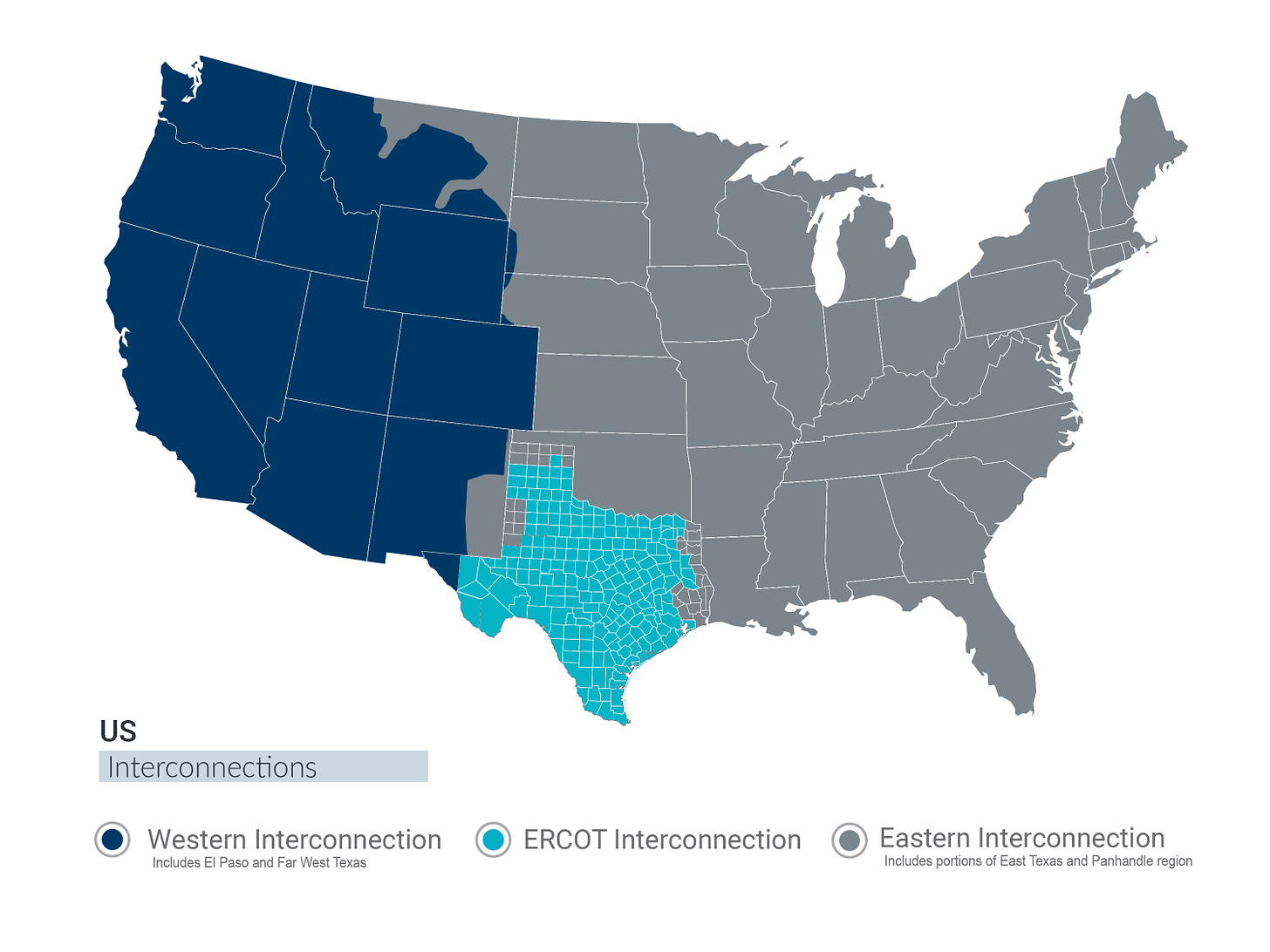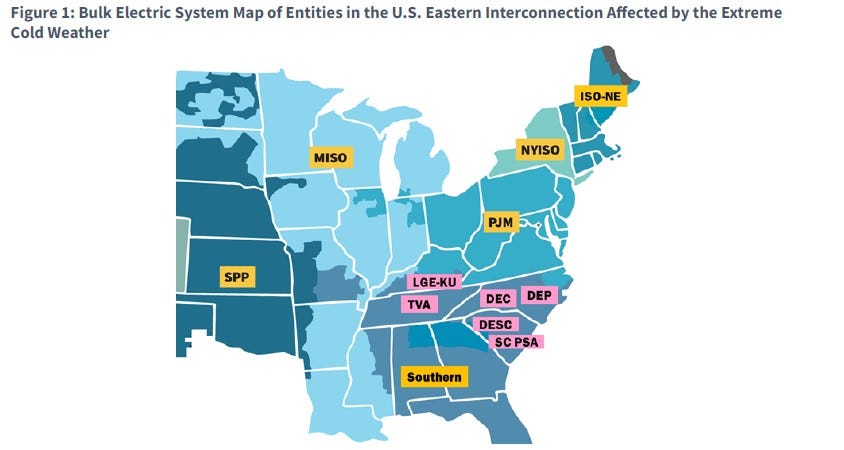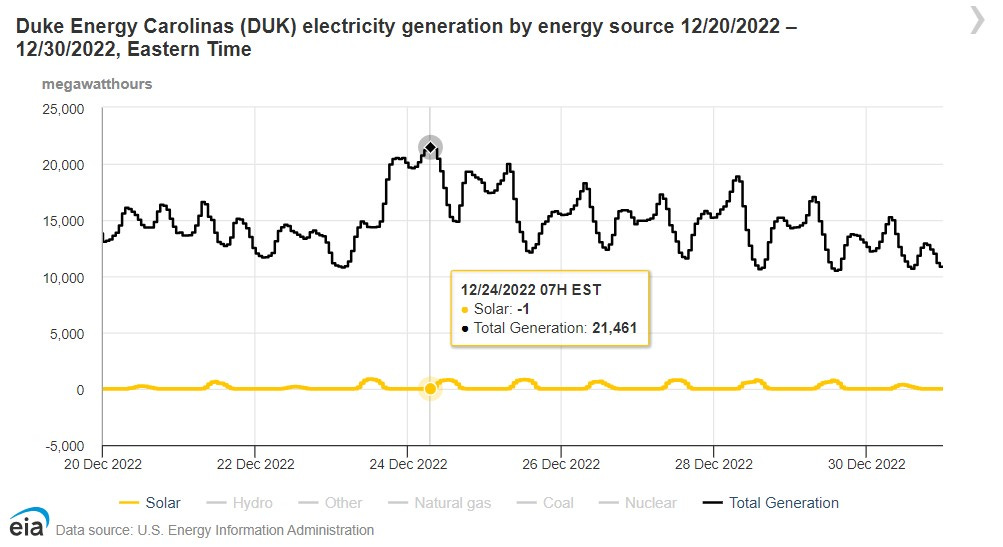Winter Storm Elliot: The Ghost of Christmas Future
History doesn’t repeat itself, but it often rhymes
One year ago today, millions of American families experienced rolling blackouts as frigid temperatures brought by Winter Storm Elliot caused fuel supply problems for natural gas power plants throughout the Eastern United States and surging demand for electricity for home heating.
Unfortunately, the latest Long-Term Reliability Assessment (LTRA) by the North American Electric Reliability Corporation (NERC) suggests that Elliot was not an isolated incident. It was the Ghost of Christmas Future.
Before we highlight some of the uncomfortable similarities between the events surrounding Winter Storm Elliot and the predictions made in the LTRA, it helps to take a step back to explain a little about how the electric system works and the factors leading blackouts to occur.
Blackouts 101
The most important thing to know about the electric system when it comes to blackouts is that electricity must be generated at the exact instant it is consumed.
If the demand for electricity increases, power plants must ramp up their production at that same moment. If demand decreases, power plants must scale back their generation to match it to prevent damage from occurring to the system.
Additionally, the grid is not a storage device, like a giant bathtub that fills with electricity for later use. Instead, the electricity generated by power plants travels instantaneously across the transmission and distribution systems for just-in-time delivery to its final destination. In other words, the electric grid is a highway, not a parking lot.
This is not how the electric grid works.
Blackouts occur when the delicate and instantaneous balancing act between supply and demand is interrupted. This can take the form of rising demand, falling supply, or both.
During Winter Storm Elliot in 2022, for example, electricity demand surged and unplanned power plant outages decreased supply, leading to the largest controlled rolling blackouts recorded in the history of the Eastern Interconnection, which encompasses most of the country East of the Rocky Mountains.
Winter Storm Elliot: Christmas Past
According to a joint report authored by the Federal Energy Regulatory Commission (FERC) and NERC, the Christmas Eve Blackouts during Winter Storm Elliot were caused by record-breaking electricity demand in many parts of the Southeastern U.S. and an unprecedented 90,500 megawatts (MW) of unplanned generating unit outages, derates, and failures.
These outages coupled with soaring demand severely limited the ability of neighboring regional grids, frequently referred to as balancing authorities, like PJM, to export power to the areas where the blackouts occurred, shown in pink in the graph below.
Map from the FERC and NERC joint report
As you can see, relying on imported electricity from neighboring regions - a popular proposal among the anti-fossil fuel crowd - as a means of securing your own grid’s reliability is already a failed solution. The lack of available imports will only get worse moving forward as more coal and nuclear power plants are retired, as the LTRA will show.
Why electricity demand was so high during Elliot
Reports from the Tennessee Valley Authority (TVA), MISO, and Bloomberg indicate that electricity demand far exceeded expectations as the cold weather enveloped Southern states.
In fact, even though TVA set new all-time high power generation records on Friday, December 23rd, 2022, it still wasn’t enough to keep up with demand on its system, forcing the company to initiate rolling outages for two hours and fifteen minutes.
Electricity demand surpassed expectations in part because there has been a massive shift in the region toward electric heating from 2009 to 2020, with Bloomberg reporting the number of households using electric heat in Tennessee, North Carolina, and South Carolina increased by about 20 percent during this timeframe, according to government data that survey a sample of households.
The situation prompted Pat Wood, the chief executive officer of Hunt Energy Network and former chairman of the FERC, to state, “We have moved too swiftly over the past two decades to electrify residential heating.”
Why power supply wasn’t able to keep up
On the supply side, the 90,500 MW power plant outages, derates, and failures were largely caused by cold weather, with electric companies citing freezing issues, mechanical issues, and natural gas fuel supply problems as the factors severely limiting the ability of the natural gas generation fleet to meet electricity demand.
Natural gas fuel supply issues stemmed from production declines in major U.S. shale basins, with gas withdrawals from the Marcellus Shale falling by 23 percent and the Utica falling by 54 percent, respectively. Additionally, Bloomberg notes natural gas flows from Appalachia to the Tennessee Valley fell by half as a result of mechanical problems at pipeline infrastructure, including at a compressor station in Ohio.
Coal units also experienced outages, with the most consequential being the Cumberland coal plant, a 2,500 MW facility owned by TVA, which tripped offline due to frozen instrumentation.
Together, these factors burned the reliability candle at both ends: increasing the demand for electricity at a time when an unprecedented number of power plants around the country failed to deliver.
Unfortunately, NERC’s LTRA suggests that energy policy in the United States will cause us to replicate these vulnerabilities to rolling blackouts in the future under less extreme circumstances.
The Long-Term Reliability Assessment: Christmas Future
According to NERC’s LTRA, a growing number of areas in North America face resource capacity or energy risks in the next ten years. The graph below shows most areas are projected to have enough reliable power plants to meet demand forecasts associated with normal weather, but areas that are red (high risk) do not meet reliability criteria moving forward.
Among the main drivers of reliability concerns in the report are the premature retirement of reliable power plants, a growing dependence on non-dispatchable wind and solar generators, the risk of fuel supply disruptions to natural gas power plants, and rising electricity demand.
In this regard, NERC’s report sounds a lot like Meredith Angwin’s seminal book, Shorting the Grid, where Angwin detailed how the fatal trifecta: an overreliance on renewables, an over-reliance on just-in-time natural gas, and an over-dependence on neighbors for imports, is actively undermining the reliability of the American electric grid.
The impact of reliable retirements
NERC’s LTRA accounted for over 83,000 MW of fossil-fired and nuclear generator retirements that are currently anticipated through 2033, with coal accounting for a large share of the retirements. An additional 30,000 MW of fossil-fired generators have announced plans to retire over the decade but have yet to enter deactivation processing with the planning authorities, which means we are set to lose more power plant capacity in the next ten years than went offline during Winter Storm Elliot.
Unsurprisingly, the two regions shown in red on the map above are scheduled to lose large amounts of reliable power plant capacity. MISO, a traditionally coal-heavy region, could potentially see more than 35,000 MW of thermal power plant retirements, losing far more reliable power plant capacity than any other region in the country, and SERC-C, the region to which the TVA belongs, could potentially lose 10,000 MW.
But why are these power plants retiring?
NERC specifically mentions the subsidies in the “Inflation Reduction Act” and the harmful impacts of the Biden Administration’s new Environmental Protection Agency (EPA) regulations on carbon dioxide emissions from new and existing coal and natural gas-fired power plants as a problem for reliability in the future.
The loss of coal plants and nuclear plants is significant because these power plants often store months, in the case of nuclear 18 months, of fuel onsite, making them far less vulnerable to fuel supply disruptions than natural gas power plants.
This makes coal and nuclear, in our opinion, superior technologies for ensuring a reliable power system.
Overreliance on wind and solar erodes reliability
NERC’s LTRA suggests our nation will grow increasingly reliant on wind and solar power, especially in the MISO region where we are based. This is a massive concern because these energy sources frequently fail to show up to work when they are needed most.
For example, many wind turbines in the Upper Midwest are designed to automatically shut off when temperatures reach -21 degrees F. These turbines also contain electric heating packages installed in the gearbox to reduce the risk of oil freezing, meaning that during extreme weather events when the energy is needed most, a substantial portion of the wind fleet will be a net consumer of electricity.
Even when wind turbines are not shutting down automatically, they often fail to perform well during cold snaps. To illustrate this point, we turn to wind performance in MISO during the 2021 Polar Vortex.
Data from the U.S. Energy Information Administration show that the entire MISO wind fleet of 22,040 MW generated less electricity than the Coal Creek Station (1,151 MW) in North Dakota for multiple hours during the frigid temperatures despite having 19 times more installed capacity than the coal plant. This wild variation means an increasing reliance on electricity for everything and the retirement of the coal fleet will be a dangerous combination for grid reliability.
While solar can help meet peak electricity demand in the summer months because peak electricity demand for air conditioning generally occurs during sunny periods, winter peak electricity demand for home heating almost always occurs at night when temperatures are lowest and the sun isn’t shining.
The graph below shows real-time electricity demand and solar generation in North Carolina during the week of Winter Storm Elliot. On December 24th, electricity demand peaks just after sunset and just before sunrise.
Attempting to meet a growing demand for electricity with a grid that is increasingly unreliable and, in many instances, physically incapable of performing during the most extreme winter weather events, is a recipe for disaster.
Natural gas for everything is a poor solution
Wind and solar advocates don’t seem to understand that building a grid that is largely composed of wind, solar, and natural gas will greatly increase the strain our gas system endures during times of peak natural gas demand because when wind and solar fail to show up for work, natural gas is the last man in the breach.
Natural gas is a great fuel, but that doesn’t mean it is the best tool for every job. The declines in gas production and transportation networks during Winter Storm Elliot show that we should keep reliable coal and nuclear plants operating as long as possible and require that all natural gas plants be dual fuel or store liquefied natural gas (LNG) on-site to prevent fuel supply interruptions from cascading into rolling blackouts.
Growing electricity demand complicates things
According to the LTRA, electricity peak demand, and energy growth forecasts over the 10-year assessment period are higher than at any point in the past decade. Some of the sharpest peak demand forecast increases, and growth rates, will be seen in winter seasons as electrification in heating systems grows.
The anticipated growth of EVs (which are expected to charge overnight and coincide with periods of electricity demand for heating) will further cause some areas, like the U.S. Southeast and Northeast, to switch from summer-peaking systems to winter-peaking systems.
This trend will complicate the ability of grid operators to meet winter peak demand with a generating fleet that is growing less dispatchable by the year.
Future outlook: It’s been better
Winter Storm Elliot may be a Ghost of Christmas Past, but it is also a window into our future as federal subsidies, EPA regulations, and state mandates for wind and solar threaten to push reliable coal plants off the grid and put all of our eggs into the wind, solar, battery storage, and natural gas basket.
When pressed, policymakers who favor these measures attempt to assure the public that they can always purchase electricity from “the market” if the wind isn’t blowing, the sun isn’t shining, and the gas stops flowing. With so much reliable power plant capacity being replaced with wind and solar, these imports are not guaranteed to show up to work when we need them most.
Unfortunately, some people simply won’t believe that we are teetering on the brink of blackouts until they actually experience one. Based on the LTRA, they may not need to wait long.
A Merry Christmas to us all; God bless us, everyone! *Unless you think the grid can be powered by wind, solar, and battery storage.*
Our friend Emmet Penney, the Nuclear Barbarian and Founder and Editor of Grid Brief, wrote this excellent piece about Meredith. Check it out and subscribe to Grid Brief!
Donate today so we can pay our graphics guy!













Excellent review of how Winter Storm Elliott overwhelmed the eastern grids, leading to massive rolling blackouts. Thank you Energy Bad Boys and Merry Christmas!
Here’s a suggestion (for those who can safely do so): consider a dual-fuel home generator with at least one fuel that you can (safely) store on site.
Natural gas home generators can be great, until the underlying natural gas pipeline system is overwhelmed (due to lots of demand or power loss, freezing etc). When another Winter Storm Elliott hits, if you’re depending on cheap nat gas to flow through that pipeline network, don’t be surprised if you have sky-high gas bills. In a worse case scenario, you might not be able to get gas at any price if the compressor that run the pipeline go offline (as pointed out in the article).
But if you have a dual-fuel generator with fuel stored on site, you might avoid that. For example, a natural gas/ propane generator. If nat gas prices skyrocket or if supplies fail during a cold snap, you can just switch the generator over to propane. (Assuming it’s installed, winterized, and maintained correctly.)
Of course, that’s a solution for people with homes or individuals with cash to spare. People who live in apartments (even if they can afford the costs) can’t typically safely have a generator. If you’re living paycheck to paycheck, a generator is low on the list of things to buy. And it goes to the social costs of declining grid reliability. A unreliable grid tends to impacts the poorest first.
Very informative. I learned lots of things, even though I thought I was already up to speed on this. Your explanation "“The most important thing to know about the electric system when it comes to blackouts is that electricity must be generated at the exact instant it is consumed." is a really simple and clear point. The point that coal and nuclear plants can store plenty of fuel to have on hand when needed is something I hadn't thought of. Your example of the shortcomings of wind farms ( the entire MISO wind fleet of 22,040 MW generated less electricity than the Coal Creek Station (1,151 MW) in North Dakota for multiple hours during the frigid temperatures despite having 19 times more installed capacity than the coal plant.") is amazing - I had no idea the difference could be that great. I also didn't realize there were problems with the supply of nat gas. Your post makes a great addition to My Two Cents post "https://alchristie.substack.com/p/the-folly-of-phasing-out-fossil-fuels".